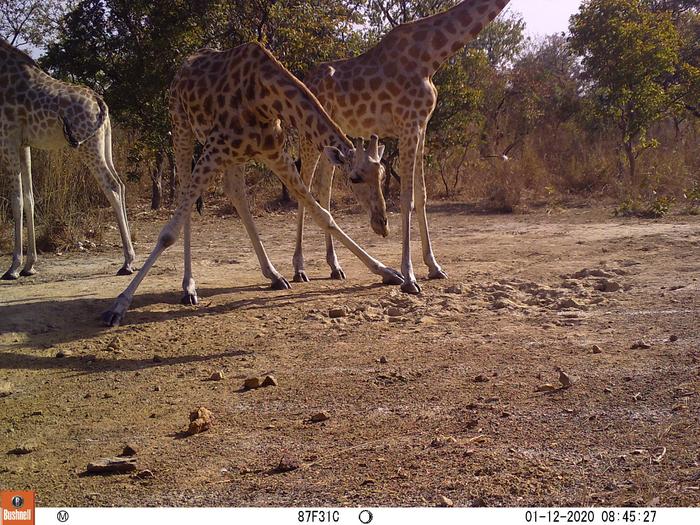For immediate release

Credit: Credit Bristol Zoological Society
For immediate release
Friday 4 August 2023
Kordofan giraffes face local extinction if poaching continues
Poaching of two Critically Endangered Kordofan giraffes per year could result in extinction in just 15 years within Cameroon’s Bénoué National Park without intervention. These are the alarming new findings of a University of Bristol and Bristol Zoological Society-led study published in the African Journal of Ecology.
One of the last populations of Kordofan giraffes roam Cameroon’s Bénoué National Park in Africa with current estimates indicating there are fewer than 50 individuals left in the park. Bristol Zoological Society have been working to conserve this highly-threatened mammal since 2017.
While poaching is frequently cited as a cause of population decline, evidence remains mostly anecdotal, with little research into its overall impact. Illegal hunters kill giraffes for their meat but also for their pelts, bones, hair and tails which are highly valued by some cultures.
Researchers from Bristol Vet School and Bristol Zoological Society sought to analyse the effectiveness of different conservation measure interventions using a population modelling technique. The team compared anti-poaching interventions, population supplementation, and habitat protection. Each intervention was simulated individually and in combination to investigate their relative impact on population viability.
Their modelling found the removal of one male and one female giraffe every year would result in an average time to extinction of just 15.3 years. The poaching of female giraffes had a more significant impact on population viability than males.
The team’s findings confirm that conservation management should prioritise strengthening existing anti-poaching activity in conjunction with protecting wildlife corridors to aid dispersal.
Kane Colston, the study’s lead author, who undertook the study as part of his Master’s degree at Bristol Vet School in conjunction with teaching partners Bristol Zoological Society, said: “Our findings confirm anti-poaching measures appear the most significant for population viability. The extent of poaching in Bénoué National Park is still unclear as far higher giraffe poaching rates have been reported in other national parks, but recent confirmed reports of the poaching of two giraffes in a period of just three months highlight the urgency of conservation intervention.”
Dr Sam Penny, the project lead from Bristol Zoological Society, added: “These findings really underscore the magnitude of the threat facing Bénoué National Park’s Kordofan giraffe and highlight the importance of our conservation work in the area. We will continue to work with the park’s Conservation Service and our partner NGO Sekakoh to ensure anti-poaching initiatives are prioritised within the landscape.”
Ends
Further information
Study at the Bristol Veterinary School
The University of Bristol offer a number of postgraduate courses including the MSc Global Wildlife Health and Conservation and a range of undergraduate degrees.
Based at Bristol’s Langford Campus, Bristol Veterinary School boasts first-class clinical facilities and encompasses a small animal hospital, a dairy farm, diagnostic laboratories, and farm animal, small animal and equine practices.
Conservation at Bristol Zoological Society
We save wildlife together, through conservation science research, working to protect species and habitats overseas, encouraging sustainable behaviours and perceptions, educating tomorrow’s wildlife warriors and connecting people with nature through a great day out.
If you would like to support our global conservation work, please visit https://bristolzoo.org.uk/support to find out ways you can help.
Notes to editors
Images of Kordofan giraffes within Cameroon’s Bénoué National Park
For further information or to arrange an interview with the researchers from University of Bristol, please contact Joanne Fryer [Mon to Wed], email [email protected], mobile: +44 (0)7747 768805 or Caroline Clancy [Wed to Fri], email [email protected], mobile: +44 (0)7776 170238 at the University of Bristol Press Office.
For further information about Bristol Zoological Society or to arrange interviews, please contact Naomi Dymond, email [email protected], tel: +44 (0)117 428 5590.
Issued by the University of Bristol media team, in partnership with Bristol Zoological Society media team.
Journal
African Journal of Ecology
DOI
10.1111/aje.13196
Method of Research
Observational study
Subject of Research
Animals
Article Title
Viability analysis of Kordofan giraffe (Giraffa camelopardalis antiquorum) in a protected area in Cameroon
Article Publication Date
3-Aug-2023



